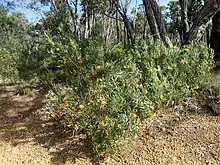| Banksia biterax | |
|---|---|
 | |
| On Mount Clarence, in Albany | |
| Scientific classification | |
| Kingdom: | Plantae |
| Clade: | Tracheophytes |
| Clade: | Angiosperms |
| Clade: | Eudicots |
| Order: | Proteales |
| Family: | Proteaceae |
| Genus: | Banksia |
| Subgenus: | Banksia subg. Banksia |
| Series: | Banksia ser. Dryandra |
| Species: | B. biterax |
| Binomial name | |
| Banksia biterax | |
| Synonyms[1] | |


Banksia biterax is a species of dense shrub that is endemic to Western Australia. It has hairy stems, deeply serrated leaves and spikes of up to 200 pale to dark brown flowers.
Description
Banksia biterax is a dense, rounded, bushy shrub that typically grows to a height of 1–2.5 m (3 ft 3 in – 8 ft 2 in) and has hairy stems but does not form a lignotuber. Its leaves are linear in outline, 150–350 mm (5.9–13.8 in) long and 4–6 mm (0.16–0.24 in) on a petiole up to 1.5 mm (0.059 in) long. The leaves are serrated to the midvein, with 60 to 110 triangular lobes and are woolly-hairy on the lower surface. The flower spikes are borne on short side branches and have between 150 and 200 pale to dark brown flowers each with a perianth 25–27 mm (0.98–1.06 in) long and a cream-coloured pistil 28–30 mm (1.1–1.2 in) long. Flowering occurs from May or July to October and the fruit is an egg-shaped follicle about 15 mm (0.59 in) long.[2][3]
Taxonomy and naming
This species was first described in 1830 by Robert Brown in the supplement to his Prodromus Florae Novae Hollandiae et Insulae Van Diemen and was given the name Dryandra baxteri.[4][5] In 2007 Austin Mast and Kevin Thiele transferred all the dryandras to the genus Banksia but as there was already a plant named Banksia baxteri, Mast and Thiele chose the specific epithet "biterax", an anagram of baxteri.[6][7][8]
Distribution and habitat
Banksia biterax grows in kwongan and eucalyptus woodland near Busselton and between the Stirling Range and Albany.[3][2]
References
- 1 2 "Banksia biterax". Australian Plant Census. Retrieved 7 April 2020.
- 1 2 "Banksia biterax". FloraBase. Western Australian Government Department of Biodiversity, Conservation and Attractions.
- 1 2 George, Alex S. (1999). Flora of Australia (PDF). Vol. 17B. Canberra: Australian Biological Resources Study, Canberra. p. 299. Retrieved 3 April 2020.
- ↑ "Dryandra baxteri". APNI. Retrieved 7 April 2020.
- ↑ Brown, Robert (1830). Supplementum primum Prodromi florae Novae Hollandiae. London: Typis R. Taylor. pp. 38_39. Retrieved 7 April 2020.
- ↑ "Banksia biterax". APNI. Retrieved 7 April 2020.
- ↑ Mast, Austin R.; Thiele, Kevin (2007). "The transfer of Dryandra R.Br. to Banksia L.f. (Proteaceae)". Australian Systematic Botany. 20 (1): 63–71. doi:10.1071/SB06016.
- ↑ Francis Aubie Sharr (2019). Western Australian Plant Names and their Meanings. Kardinya, Western Australia: Four Gables Press. p. 147. ISBN 9780958034180.
- Cavanagh, Tony; Pieroni, Margaret (2006). The Dryandras. Melbourne: Australian Plants Society (SGAP Victoria); Perth: Wildflower Society of Western Australia. ISBN 1-876473-54-1. OCLC 149312882.